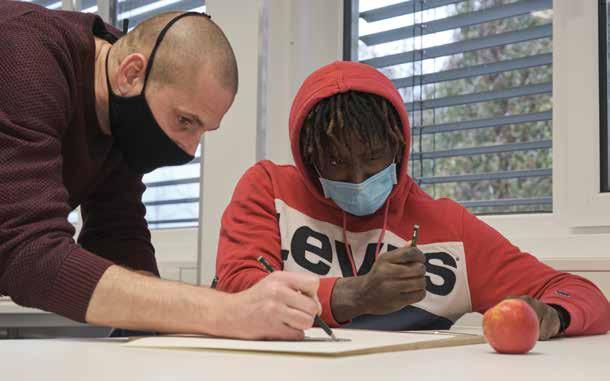
4 minute read
A new vitality in the form‘s endless flexibility Two founding members of the Supports/Surfaces movement questioning painting itself
A NEW VITALITY IN THE FORM‘S ENDLESS FLEXIBILITY
TWO FOUNDING MEMBERS OF THE SUPPORTS/SURFACES MOVEMENT, VIALLAT AND SAYTOUR, QUESTIONING PAINTING ITSELF
© éric chenal
Saytours monumental Pliage (1969) came to the museum with the generous support of the Amis des Musées last year.
One of the undeniable strengths of the MNHA’s collection of international art is the ensemble of paintings by an artistic movement from 1966-1972 which helped laying the foundation for contemporary French art, both in painting and sculpture: Supports/Surfaces. In fact, the museum, with the Centre Pompidou in Paris, houses one of the most important public collections worldwide of artists belonging to - or associated with Supports/Surfaces. This collection, which has been carefully built up over many years, is still actively strengthened with donations and purchases. From 21 December 2020 to 29 August 2021 important acquisitions from recent years are shown in the context of our rich museum holdings in this field. The presentation focuses on works by two founding members of the Supports/Surfaces movement: Patrick Saytour (b.1935) and Claude Viallat (b.1936). Of the eleven works on display by these two giants of French modern painting, no less than five were acquired by the MNHA in 2019 and 2020. Saytours monumental Pliage (1969), which came to the museum with the generous support of the Amis des Musées, is among the works that can now be shared with our visitors for the first time.
As for beginnings: Supports/Surfaces had its birthplace in the south of France, where most of the group’s earliest members lived and worked, in cities like Montpellier, Nîmes and Nice (the latter two cities are in fact the birthplaces of Viallat and Saytour, respectively). There they were part of a group of twelve artists, notably with Vincent Bioulès, Louis Cane, Daniel Dezeuze, Jean-Pierre Pincemin and Bernard Pagès, along with several others who were closely affiliated. From the start, their work was marked by an interest in materiality, a lyrical use of color and expansive ideas of what constitutes a painting.
DEMISTIFYING THE FORM
The group’s name refers to their attempt to strip painting down to its most essential components. Surface alludes to the canvas of a painting, while support refers to the stretcher bars that gives a painting structural integrity. By exposing the conventions and processes of painting, they hoped to demystify the form while proposing new possibilities to explore. The artists of the group also questioned the art market, as well as certain rules about dating and signing works. They had a heartfelt desire to return to a sort of reductive and essential art practice. Claude Viallat summarized it as follows: «Dezeuze painted frames without canvas, I painted canvas without frames and Saytour the image
of the frame on the canvas.» It is clear that members of the loosely-knit collective aimed at deconstructing the fundamental objecthood of painting, at a time when an attack on the autonomy of art was being mounted all over the world. French culture was undergoing many swift and profound changes in the 1960’s. Anti-colonial uprisings in Vietnam and Algeria created waves of anger among the population. Several members of Supports/Surfaces were soldiers involved in these conflicts and saw the effects of these wars firsthand. Students and workers in France began social protests and strikes in May of 1968 and the French government responded by entering the universities and factories, forcibly trying to quell the uprising. Artists in the group were active participants in these protests as well. Several art works by Viallat and Saytour in the MNHA presentation reflect these tensions and make subtle gestures against consumerism and imperialism that seemed to be the norm at the time. It is notable that Supports/Surfaces is invested in exploring weaving, knot tying and dying: artisanal skills that were beginning to be lost.
ART IN PUBLIC SPHERE
These artists were attracted to ideas outside French culture: Abstract Expressionism, Native American art and craft, Chinese ink painting, minimalism, and leftist political theory of many stripes including Maoism. They started a journal called Peinture. Cahiers Théoriques (in English: theoretical painting notebooks) to discuss and debate their ideas publicly. They also made exhibitions outside art galleries and museums, taking their art into the public sphere holding impromptu exhibitions in cafes, on beaches and other public spaces. The artists sought to take active control of the production and display of their artworks, and by extension imbue the works social and even political content. Given the exciting search of the artists involved and the quality of the paintings produced by the movement, it comes as no surprise that their work found its way to museums and art galleries all over the world. The MHNA exhibition shows that Viallat and Saytour explored how their work was impacted by a rejection of traditional painting, without throwing everything overboard. They managed to hold onto parts of the form while simultaneously scrapping components of painting. This philosophical rejection and partial preservation of painting allowed them to find new vitality in the form’s endless flexibility, which will hopefully delight many visitors to the MNHA’s extraordinary collection of works by both artists in the coming months. Ruud Priem













